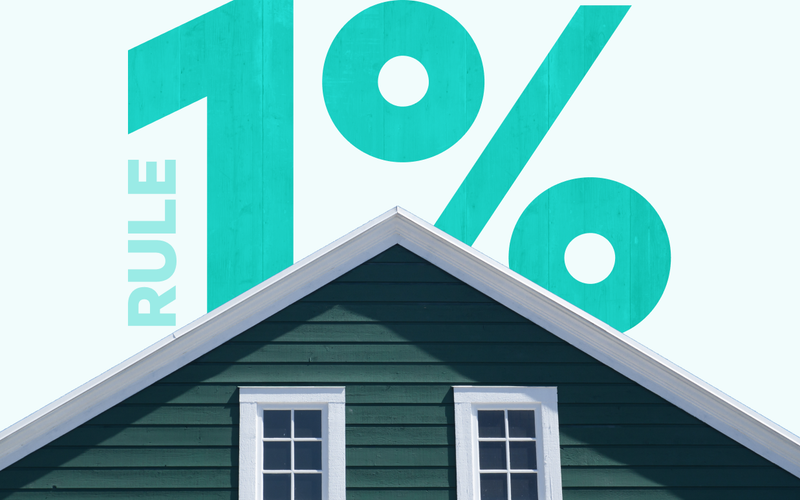Real estate investors have two distinct metrics to measure a rental property’s viability and profitability: appreciation and rental income. While appreciation can be easier to predict based on historical growth indicators and the popularity of an area, rental income can be slightly trickier to judge. What counts as “good” rental income? Is it just enough to cover your mortgage, or are there other calculations to keep in mind?
Enter: The 1% rule.
The 1% rule (or the one percent rule) is a quick, back-of-the-napkin real estate calculation that helps investors decide whether a property’s rental income makes it a good purchase. Let’s talk about the 1% rule, when you should use it, and why it doesn’t always work.
What is the 1% rule?
The 1% rule is a simple calculation to determine whether an investment property’s cash flow makes it a good buy. Simply put, the 1% rule is a helpful pre-screening tool to judge a property’s viability without doing extensive research and number crunching.
To run the 1% rule on a property, calculate 1% of the property’s purchase price to determine the minimum monthly rent to charge. That is:
Purchase price of the property x 0.01 = Minimum monthly rent
As a rule of thumb, if you can set 1% of a property’s value as rent, given the property’s condition, the neighborhood, and current monthly rental prices in the area, you can move to the next step of further evaluating the property. If not, the property may not be viable as a rental income purchase.
When calculating the property’s price, you want to do your due diligence and consider any repairs, renovations, and upgrades that you do on the property. This must be added to the total cost price.
Let’s say you purchase a property for $140,000 and undertake repairs and renovations worth $10,000. Your total cost of buying this property is now $150,000.
If we were to apply the 1% rule, the minimum rent price you should charge for the property would be $1,500 (1% of $150,000.)
It’s important to point out that the 1% rule, despite its name, is not a rule but a guideline. It’s simply a preliminary check that gives you some measure of a property’s profitability and baseline rent and allows you to consider whether it’s worth exploring further.
Advantages of the 1% rule
There are several situations where the 1% rule can come in handy, including:
Early stage pre-screening
Many factors determine whether a rental property will be profitable. These include the property, neighborhood, school proximity, local amenities, economy, property taxes, and future development. It is, however, a waste of time to do all this research only to find out that the property wouldn’t have been cash flow positive regardless of all these factors.
The 1% rule allows you to run a simple mathematical calculation as a preliminary screening. If you’re considering purchasing a property for $100,000, for example, but the rents in the area for properties of a similar size are $500 with little room to grow, you can eliminate that investment option without putting additional time or effort into it.
Vet multiple properties quickly
Time is money, and real estate investing—if done inefficiently—can soak up a lot of your time. The 1% rule allows you to do quick cash on cash return calculations on several properties and narrow down the listings for positive cash flow before you spend time evaluating them individually.
Understanding the market
The 1% rule can also give you an overview of the real estate market you’re looking at. If all the properties you’ve shortlisted are failing the 1% rule, perhaps that’s more an indication of current market trends or the neighborhood than just one particular property. Similarly, if most of the properties in an area pass the test, that could signal a robust rental market and, therefore, a profitable purchase.
Limitations of the 1% rule
Sometimes a property may not meet the 1% rule but still be an excellent real estate investment. Here are some limitations of the rule that you should keep in mind when evaluating a potential purchase.
It doesn’t work in all real estate markets
While the 1% rule holds true in many locations and markets, it isn’t universally true. In some of the most expensive cities, such as New York and San Francisco, the 1% rule doesn’t work. Consider, for instance, the median price of real estate in Manhattan, which is $1.2 million. Based on the 1% calculation, the minimum you’d charge from renters would be $12,000. The median rent in the same period, however, stood at $4,050.
This doesn’t mean that property in Manhattan isn’t a good investment. The median price per square foot in Manhattan, at $979, has had a 6% year-on-year change.
Low rent, high appreciation
While many investors look at monthly cash flow and appreciation as factors when purchasing an investment property, others prioritize one over the other. If your goal is to maximize the appreciation of the property, then the rental income may not matter as much to you. In such a case, the 1% rule may not be your primary tool for decision-making, and you may want to use the internal rate of return (IRR) instead.
It doesn’t take expenses into account
While the 1% rule considers upfront costs such as renovations and modifications to the property, it doesn’t account for day-to-day expenses such as maintenance, property taxes, homeowner association (HOA) dues, insurance, closing costs, property management costs, and other operating expenses. You will need to consider these numbers in addition to the mortgage payment when evaluating whether your rental income from the property covers all your costs.
Inflated market rates
The 1% rule works well in most markets most of the time. However, in the last two years during and after the pandemic, with homes being in short supply and near-zero interest rates, house prices have inflated by as much as 40%. While a correction will most likely happen in the coming year, if you’re purchasing during a time of inflated house prices, the 1% rule can mislead you into believing the rent on your investment property needs to be higher than expected.
Other real estate rules to consider
Since rental income on a property can vary widely between locations and rental markets, various other real estate rules and metrics can be used in addition to the 1% rule. Let’s talk about some of them and when it makes sense to use them.
The 50% rule
What the 1% rule ignores, the 50% rule highlights – namely, operating expenses. The 50% rule is used to analyze multifamily and single-family homes, assuming that 50% of generated revenue will be spent on overhead costs, such as property taxes, maintenance, utilities, etc. This is a long-term average estimate, so in addition to the fixed monthly costs, you’d also consider more significant expenses such as replacing ACs, gutters, roofs, and so on. Assuming you’ll be spending 50% of what you make in rental income gives you an idea of your actual profit margins over the years you’ll hold the property.
The 70% rule
The 70% rule is most frequently used by investors who flip houses. According to the 70% rule, an investor should pay no more than 70% of a property’s estimated After Repair Value (ARV) minus repair costs. This formula is helpful in coming to a fair market value of a potential purchase. However, as with the 1% rule, there can be variability depending on the real estate market or location you’re operating in.
Gross rent multiplier
The gross rent multiplier, or GRM, is used to gauge how long it will take for you to pay off a rental property. The gross rent multiplier is calculated using the following formula:
Gross rent multiplier = Property purchase price / Gross annual rental income
You arrive at the number of years it will take to pay off your investment using just your rental income. The lower the number, the more lucrative your property will likely be. Again, operating expenses and vacancy rates are not included in this number, and they could significantly impact whether you get a good return on investment. The gross rent multiplier is often used in addition to the 1% rule.
Cap rate
A popular alternative to the gross rent multiplier is the capitalization rate. To arrive at the cap rate, you must first calculate your Net Operating Income (NOI), which is the gross rental income, minus all expenses (excluding monthly mortgage payments and interest). The cap rate is the NOI divided by the sales price.
The percentage you arrive at tells you the return on an investment before financing costs. Comparing the cap rate of a potential property to average cap rates in the area can be an excellent way to evaluate whether it’s a good investment.
Start your real estate investing journey
The bottom line is that rental properties are one of the most profitable ways to make money through real estate investing. If you’re ready to start your real estate journey through rental properties, let us help.
At Arrived, we simplify the process for you by selecting some of the best rentals available. You can purchase shares in any of these homes to take advantage of passive income and long-term appreciation. Browse our available properties to get started today.







